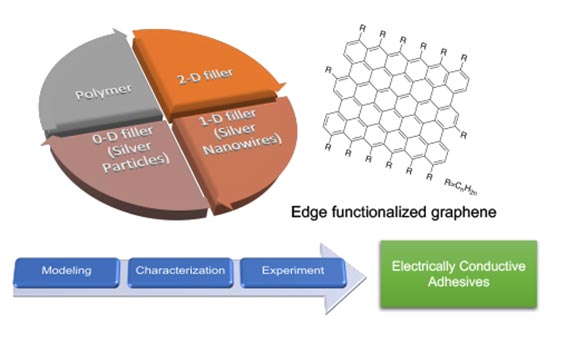Highly Conductive, Low-Cost Polymer Adhesive Composites with Complex Dimensional Fillers
As a DuraMAT project, the University of Akron (UA) will develop low-cost and highly conductive polymer adhesive composites for photovoltaic (PV) modules.
To reduce the required filler content through decreasing the percolation threshold, UA will use a novel, synergistic combination of the following in flexible polymer matrices:
- 0-D filler (silver particles)
- 1-D filler (silver nanowires)
- 2-D filler (edge functionalized graphene flake and graphene nanoribbons).
This development seeks to ease applicability, decrease cost, and improve bonded strength without adversely impacting conductivity. It will leverage the expertise of UA's College of Polymer Science and Polymer Engineering, and Sandia National Laboratories to address this challenge through an integrated materials development and characterization approach.
This work aims to develop next-generation, conductive polymer composites for enhanced performance PV modules and experimentally validated models to predict the properties of complex nanocomposites.
Core Objective
Location
University of Akron and Sandia National Laboratories
Applications
The integration of multiple conductive filler with different aspect ratios in polymer composites enhance the formation of a robust percolation network to achieve the desired conductivity at lower total filler loading than with typical silver particles. For the rational design of novel conductive composite that will be economically viable for PV, it's pivotal to understand the synergistic effect of multiple scale fillers in polymer composites and the development of a quantitative composition-property relationship model.
Availability
The compositions and models developed will be available to NREL scientists and DuraMAT collaborators after Sandia National Laboratories and UA fill intellectual property.
References
Morris, J. E. (1999) Electrically Conductive Adhesives: A. Comprehensive Review in Conductive Adhesives for Electronics Packaging. UK: Electrochemical Publications. 37–77.
Zhu, Y.; Lu, W.; Sun, Z. Z.; Kosynkin, D. V.; Yao, J.; Tour, J.M. (2011). “High Throughput Preparation of Large Area Transparent Electrodes Using Non-Functionalized Graphene Nanoribbons.” Chemistry of Materials. 23: 935–939.
Prichard, T.D.; Vogt, B.D. (2013). “Comparison of Flocculated and Dispersed Single‐Wall Carbon Nanotube‐Based Coatings Using Nonionic Surfactants.” Polymer Engineering and Science. 53, 69–77.
Contact
To learn more about this project, contact Yu Zhu.
